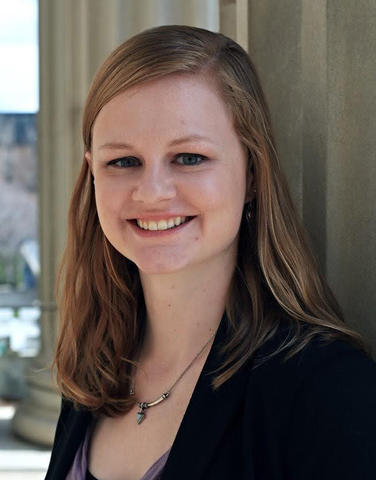
Alex Doyle
PhD Thesis:
Investigating the effects of subthalamic nucleus stimulation on gait and pedunculopontine nucleus activity in a preclinical animal model of Parkinson’s disease.
Current Position:
Neuromodulation Project Manager, Abbott
Undergraduate Institution and Major:
University of Pittsburgh, B.S., Neuroscience major, chemistry minor, 2013
Graduate Advisor:
- Matthew Johnson, PhD, Department of Biomedical Engineering
Description of Graduate Research:
I am investigating the neurophysiological basis of gait dysfunction in a model of Parkinson’s Disease. My focus is relating known behavioral gait changes with parkinsonism onset with unknown neuronal changes in the centromedian nucleus of the thalamus and the pedunculopontine nucleus of the brainstem. Furthermore, I will look into subthalamic nucelus deep brain stimulation effects on neuronal firing/pattern changes and gait kinematics.
Graduate Publications:
- Classification of electrically-evoked potentials in the parkinsonian subthalamic nucleus region. Sci Rep. 2023 Feb 15;13(1):2685.
- Brinda AK, Doyle AM, Blumenfeld M, Krieg J, Alisch JR, Spencer C, Lecy E, Wilmerding LK, DeNicola A, Johnson LA, Vitek JL, Johnson MD. Longitudinal analysis of local field potentials recorded from directional deep brain stimulation lead implants in the subthalamic nucleus. J Neural Eng. 2021;18 046050.
- Johnson L, Alekseichuk I, Krieg J, Doyle A, Yu Y, Vitek J, Johnson M, Opitz A. Dose-dependent effects of transcranial alternating current stimulation on spike timing in awake nonhuman primates. Sci Adv. 2020 Sep 2;6(36):eaaz2747.
Professional Presentations
Oral presentations:
- Doyle A. The role of the centromedian and pedunculopontine nuclei in motor function during naïve, parkinsonism and DBS conditions. Graduate Program in Neuroscience Colloquium Series, Minneapolis, MN, June 2018.
- Doyle A. Investigating the centromedian and pedunculopontine nuclei and their role in motor function during naïve, parkinsonism and DBS conditions. IGERT-Neuroengineering Training Program Innovation Session, Minneapolis, MN, December 2017.
- Doyle A, Zhang S, Peña E, Yeatts M, Johnson M. A particle-swarm optimization algorithm for predicting deep brain stimulation settings that improve parkinsonian motor signs. The Biomedical Engineering Society Annual Meeting, Phoenix, AZ, October 2017.
Poster Presentations:
- Kovach-Brinda A, Doyle AM, Wilmerding LK, Krieg J, Johnson MD. Longitudinal relationships between deep brain stimulation electrode impedances and local field potential recordings in the subthalamic nucleus. The Society for Neuroscience annual meeting, Washington, D.C., November 2018.
- Kovach-Brinda A, Doyle AM, Wilmerding LK, Krieg J, Johnson MD. The impact of deep brain stimulation electrode-tissue interface dynamics on local field potential recordings in the subthalamic nucleus. The Institute for Engineering in Medicine Annual Conference and Retreat, Minneapolis, MN, September 2018.
- Rosing J. Bellow EM, Wilmerding LK, Kreig J, Doyle A, Johnson M. Features of evoked compound action potentials in non-human primate thalamic deep brain stimulation. Neural Interfaces Conference, Minneapolis, MN, June 2018.
- Doyle A, Zhang S, Peña E, Yeatts M, Madden L, Demuth S, Molnar G, Netoff T, Vitek J, Johnson M.. A particle-swarm optimization algorithm for predicting deep brain stimulation settings that improve parkinsonian motor signs. The Society for Neuroscience annual meeting, Washington, D.C., November 2017.
- Doyle A, Zhang S, Peña E, Yeatts M, Madden L, Demuth S, Molnar G, Netoff T, Vitek J, Johnson M. A particle-swarm optimization algorithm for predicting deep brain stimulation settings that improve parkinsonian motor signs. Institute for Engineering in Medicine Annual Conference and Retreat, Minneapolis, MN, November 2017.
- Doyle A, Zhang S, Peña E, Yeatts M, Johnson M. A particle-swarm optimization algorithm for predicting deep brain stimulation settings that improve parkinsonian motor signs. The Society for Neuroscience annual meeting, Washington, D.C., November 2017.
- Doyle A, Krieg J, Wilmerding LK, Madden L, Demuth S, Zhang S, Molnar G, Netoff T, Vitek J, Johnson M. Quantifying axial motor signs in the non-human primate MPTP model of Parkinson’s Disease. The 19th Annual NINDS Udall Centers Meeting, Bethesda, MD, October 2017.
Graduate Honors/Awards:
- Boston Scientific Poster Award at the Minnesota Neuromodulation Symposium 2021
- Ruth L. Kirschstein Predoctoral Individual National Research Service Award (NIH F31 Fellowship) 2018
- Graduate School Excellence Research Grant (UMN internal award)
- IGERT Systems Neuroengineering associate member 2017
GPN Committee(s):
- Grants Coordinator for the Career Facilitation Committee, 2017-2018
- Career Facilitation Committee (CFC) Member, 2016- 2018
- Student Board Class Representative (elected), 2015-2017
Professional Outreach:
- The National Parkinson's Foundation's Moving Day 2017
- GPN Brain Booth at the Minnesota State Fair 2016
- Clinical Neuroscience Brain Booth at the Minnesota State Fair 2016
- Minnesota State Science Bowl 2016
- Graduate Student Panel for the UMN Undergraduate Brain Club 2016
- Minnesota State Science Bowl 2016
Professional Memberships:
- Society for Neuroscience Student Membership
- Biomedical Engineering Society Student Membership
Thesis Committee Members:
- Matthew Johnson, Ph.D., Department of Biomedical Engineering (Chair)
- Timothy Ebner, MD., Department of Neuroscience
- Colum MacKinnon, Ph.D., Department of Neurology
- Matthew Chafee, Ph.D., Department of Neuroscience
Research Categories:
- Motor Control, Muscle Function, & Disease
- Neurodegenerative Diseases & Neural Injury
- Neuroengineering
Rotations:
- Colum MacKinnon, Ph.D., Department of Neurology
- Matthew Johnson,Ph.D., Department of Biomedical Engineering
- Esther Krook Magnuson, Ph.D., Department of Neuroscience
- Timothy Ebner, MD., Department of Neuroscience
What Got You Interested In Research?
I was first interested in research after learning about how diseases affect the brain and wanting to find out more about how disrupting neural circuits resulted in abnormal behaviors. I am most interested in translating that basic knowledge of disease research into therapeutics for human patient populations.
Why Did You Choose MN?
I chose to join the GPN for three main reasons: 1) There were several neurodegenerative disease research laboratories that I was interested in 2) I wanted to join the NSF IGERT program and learn more about neural engineering, and 3) I liked the close-knit and supportive community of the GPN students and faculty.
Student Mentor and the Best Advice They Gave.
Zoé Christenson Wick: “Watch Jessica Jones.”
